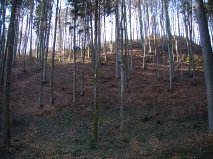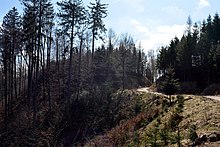Bergheim Castle
| Bergheim Castle | ||
|---|---|---|
|
Burgstall Bergheim am Schlossberg near Bergham |
||
| Castle type : | Hilltop castle | |
| Conservation status: | Burgstall | |
| Place: | Geboltskirchen -Bergham | |
| Geographical location | 48 ° 9 '53 " N , 13 ° 36' 54.4" E | |
|
|
||
The castle Bergheim , even height spur investment Berg Haim or Bergham called, is a Outbound hilltop castle near the hamlet Bergham of Geboltskirchen am Schlossberg, but is not - as is sometimes assumed - in this county, but in Haag am Hausruck in Grieskirchen of Upper Austria .
history
Local researchers assume, based on the name ending -heim (or -ham), that the first castle building can be traced back to the time of settlement by the Bajuvars between 600 and 800 AD. The actual castle building is likely to have been built around 1000 AD.
The castle was probably the ancestral seat of the Lords of Bergheim (Perchheimer, Perghaimer). This interpretation is controversial, however, possibly the existing castle ruins are Husrukke Castle . In addition, the location of the original seat of the Berghamer (Bergheimer) is not clear, as there were other Bergheims in the 12th and 13th centuries and still today.
The Perkheimers are said to have been at home in Oberbergheim (between Haag am Hausruck and Ampflwang ) first. From this noble family are known: Adelbero de Perchheim (around 1110), Adelhalm and Adalram von Perchheim (1140), Rudolfus de Perchhem (1151), Altmann de Peechen (1150), Heinrich I. de Perchheim (1190), Friedrich I. und Reicher I. von Pergheim (1220), Reicher II. Von Pergheim (1282, 1287, 1298, 1301, 1306), Walchun von Pergheim (1387, 1398), Heinrich II. Von Pergheim (1306) and Otto (e) von Pergheim (1316, 1321, 1325, 1328, 1331). After that, the Perkhaimer are in the Mühlviertel on the local seat Bergheim be moved. The Perkheimers can also be proven at Würting Castle in Offenhausen , although this rule came to the Perkheimers through a marriage between Jörg Perkhaimer and Susanna Rathalminger in 1422.
In 1334 the Perkheimers named Heinrich von Schaunburg as their feudal lord. In 1339 the lords of Schaumburg gave the Rudigier grandson the “Gesats datz Perkhaimb” as a fief . The seat of the Perkheimers had already fallen into disrepair in 1640.
Location of Bergheim Castle
The Burgplatz is about 900 m above sea level above the Bergham district. You can get to it by following the so-called Eselgraben on the Schlossberg. The castle complex was located there on an area of about one hectare. The actual Burgplatz is separated from a forecourt by two ditches ; a connecting bridge can be assumed here. The main castle extended to 100 m in length and 50 m in width. The building was not made of wood (as was often found in those days), but made of stone. The walls of the surrounding ring wall should have been 2 m. Presumably, the plant had a west-facing dungeon .
Fragments were found here that can be dated from around 1100 (earthenware containing graphite) to around 1330 (white Hausrucker ceramics). No finds could be dated after the middle of the 14th century. Iron finds (spearheads, pommel of a German knight's sword, crossbow bolts) could also be made; Particularly noteworthy is a 27 cm long Gothic key (around 1300). The finds point to a violent demise of the castle at the beginning of the 14th century. At this time (1322) there is also a report about the siege of the nearby Starhemberg Castle ; possibly the residents of Bergheim Castle rushed to the Starhembergers' aid, but were then defeated and the castle was set on fire. In the course of later centuries, the building material was collected from farmers and used to build houses. Today the Burgplatz is difficult to access due to a young forest.
This historically significant complex is unfortunately not a listed building and was considerably disturbed by the creation of forest roads.
literature
- Oskar Hille: Castles and palaces in Upper Austria then and now . Verlag Ferdinand Berger & Sons, Horn 1975, ISBN 3-85028-023-3 .
- Irene Keller, Christian Keller: From Gebrulteskirch to Geboltskirchen: History of the community Geboltskirchen am Hausruck. Home register of the community of Geboltskirchen . Verlag Moserbauer, Ried im Innkreis 2009, ISBN 978-3-902684-08-0 .
- Josef Reitinger: The prehistoric and early historical finds in Upper Austria (= series of publications of the Upper Austrian Museum Association . Volume 3 ). Upper Austrian Provincial Publishing House, Linz 1968.
- Christian K. Steingruber : A critical consideration of the historical-topographical manual of the fortifications and mansions of Upper Austria . Upper Austrian Provincial Archives , Linz 2013.
Individual evidence
- ↑ Christian K. Steingruber , 2013, p. 115.
- ↑ Josef Reitinger, 1968, p. 106.
Web links
- Entry on Bergheim Castle in the private database "Alle Burgen".


